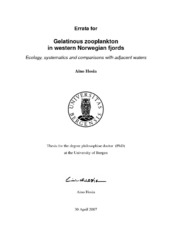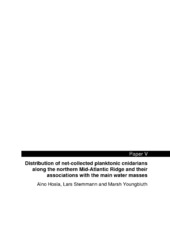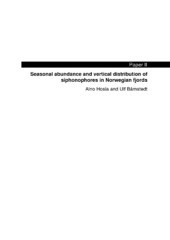| dc.contributor.author | Hosia, Aino | eng |
| dc.date.accessioned | 2007-08-23T12:06:04Z | |
| dc.date.available | 2007-08-23T12:06:04Z | |
| dc.date.issued | 2007-05-16 | eng |
| dc.identifier.isbn | 978-82-308-0374-5 (print version) | en_US |
| dc.identifier.uri | https://hdl.handle.net/1956/2353 | |
| dc.description.abstract | Gelatinous zooplankters, also known as jellies, are ubiquitous in the marine pelagic. Medusae, siphonophores and ctenophores are voracious predators that can, when abundant, have significant structuring effects on the pelagic community. Many jellies exhibit opportunistic life history characteristics such as short generation times, asexual reproduction or hermaphrodism, high fecundity, rapid growth, and ability to exploit high food concentrations effectively. While siphonophores and ctenophores are generally holoplanktonic, most scypho- and hydromedusae are meroplanktonic with a benthic polypoid stage. These characteristics contribute to the naturally pulsed occurrence of jellies in the plankton. In order to assess the role of jellies in the fjord ecosystems, information on the identity, seasonal abundance, distribution and behaviour of the species constituting the gelatinous community is necessary. This thesis attempts to fill in several gaps in knowledge regarding the systematics and ecology of gelatinous zooplankton in western Norwegian fjords. In order to do so, both net based sampling and remotely operated vehicles (ROVs) have been utilized. Seasonal changes in the gelatinous community as a whole as well as the abundances of the individual species in Korsfjord and Fanafjord, western Norway, were examined. The gelatinous communities showed a clear seasonal succession, with maximum diversity and abundance occurring in April-June. Aglantha digitale was numerically dominant in both fjords. Meroplanktonic hydromedusa species appeared sequentially and were most common during the summer months. During the winter, the siphonophores Nanomia cara, Lensia conoidea and Dimophyes arctica formed the bulk of the community especially in Korsfjord. While the two fjords had rather similar faunas, they differed in terms of the relative importance of the observed groups. Siphonophores were prominent in the more oceanic Korsfjord, while Fanafjord was characterized by meroplanktonic hydromedusae. A community of deep-water hydromedusae was found at the deeper stations at Korsfjord. Two new species presumed to be members of this deep-water community, Foersteria quadrata and Parateclaia norvegica, are described in this thesis. The vertical distribution of animals in a fjord has relevance in terms of degree of overlap with prey and predator distributions as well as the likelihood of being advected from the fjord. Exchange of fjord water is most pronounced in the layers occurring above sill depth, while the sill promotes the retention of basin water. The holoplanktonic Aglantha digitale and Nanomia cara both seem to facilitate their retention in the fjords by residing below sill depth when mature. Younger stages of both species are known to have a shallower distribution, and may thus be more susceptible to advective transport. Comparison with results from the northern portions of the Mid-Atlantic Ridge (MAR) show that the same species of planktonic cnidarians (A. digitale, N. cara, L. conoidea and D. arctica) dominated the epipelagic both in Korsfjord and the corresponding latitudes at the MAR. However, the mesopelagic siphonophores and medusae common at the MAR (e.g. Chuniphyes multidentata, Gilia reticulata, Pantachogon haeckeli and Aeginura grimaldii) seem to have been unable to colonize the fjords. The notable exception to the above rule is Periphylla periphylla, a coronate midwater scyphomedusa with abundant populations in certain west Norwegian fjords. Large P. periphylla in Lurefjord were shown to feed primarily on Calanus spp., but also on krill and ostracods. They behaved as ramming predators, approaching their prey tentacles first in order to minimize fluid disturbance, and were found to have clearance rates comparable with other gelatinous predators of similar size. The horizontal and vertical distributions of siphonophores were found to be negatively correlated with P. periphylla distribution. | en_US |
| dc.language.iso | eng | eng |
| dc.publisher | The University of Bergen | en_US |
| dc.relation.haspart | Paper I: Hosia, Aino and Ulf Båmstedt, Seasonal changes in the gelatinous zooplankton community and hydromedusa abundances in Korsfjord and Fanafjord, western Norway. Preprint. Accepted for publication in Marine Ecology Progress Series. Published by Inter Research. | en_US |
| dc.relation.haspart | Paper II: Hosia, Aino and Ulf Båmstedt, Seasonal abundance and vertical distribution of siphonophores in Norwegian Fjords. Accepted version. | en_US |
| dc.relation.haspart | Paper III: Hosia, Aino and Francesc Pagès, Unexpected new species of deep-water Hydroidomedusae from Korsfjorden, Norway.In press, Marine Biology online first. Published in Marine Biology 151(1): 177-184. Copyright 2007 Springer Verlag. Abstract only. Full-text not available due to publisher restrictions. <a href”http://dx.doi.org/10.1007/s00227-006-0466-2”target=_”blank”> http://dx.doi.org/10.1007/s00227-006-0466-2</a> | en_US |
| dc.relation.haspart | Paper IV: Sørnes, Tom A.; Hosia, Aino; Båmstedt, Ulf and Dag L. Aksnes, Swimming and feeding in the stealth predator Periphylla periphylla (Scyphozoa, Coronatae). Preprint. Conditionally accepted for publication in Marine Biology. Published by Springer Verlag. | en_US |
| dc.relation.haspart | Paper V: Hosia, Aino; Stemmann, Lars and Marsh Youngbluth, Distribution of net-collected planktonic cnidarians at the northern Mid-Atlantic Ridge and their associations with the main water masses. Preprint. Accepted for publication in Deep-Sea Research II. Published by Elsevier Science. | en_US |
| dc.title | Gelatinous zooplankton in western Norwegian fjords. Ecology, systematics and comparisons with adjacent waters | en_US |
| dc.type | Doctoral thesis | |
| dc.subject.nsi | VDP::Matematikk og Naturvitenskap: 400::Zoologiske og botaniske fag: 480::Marinbiologi: 497 | nob |




